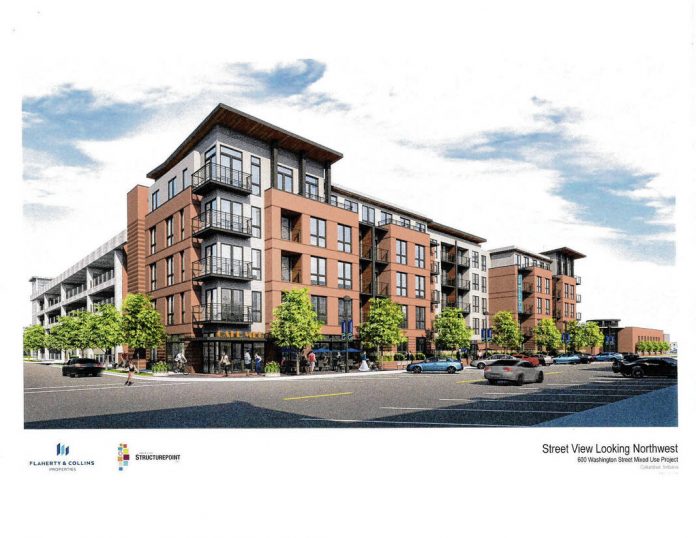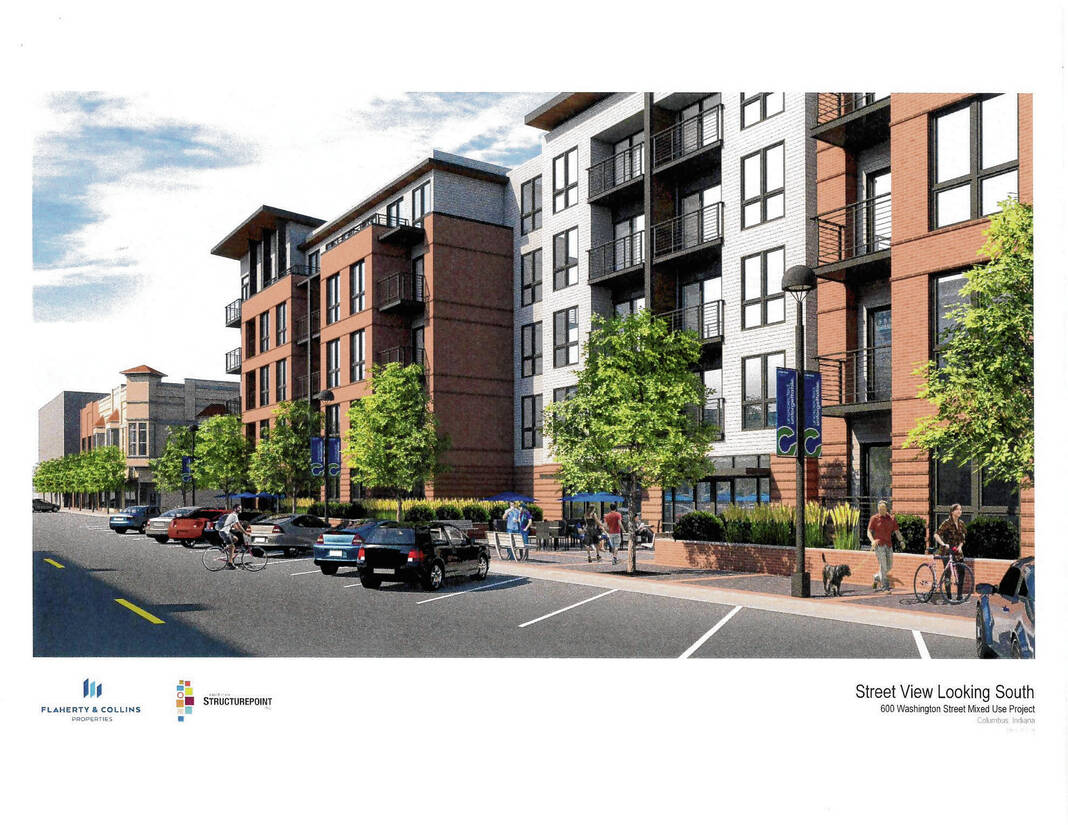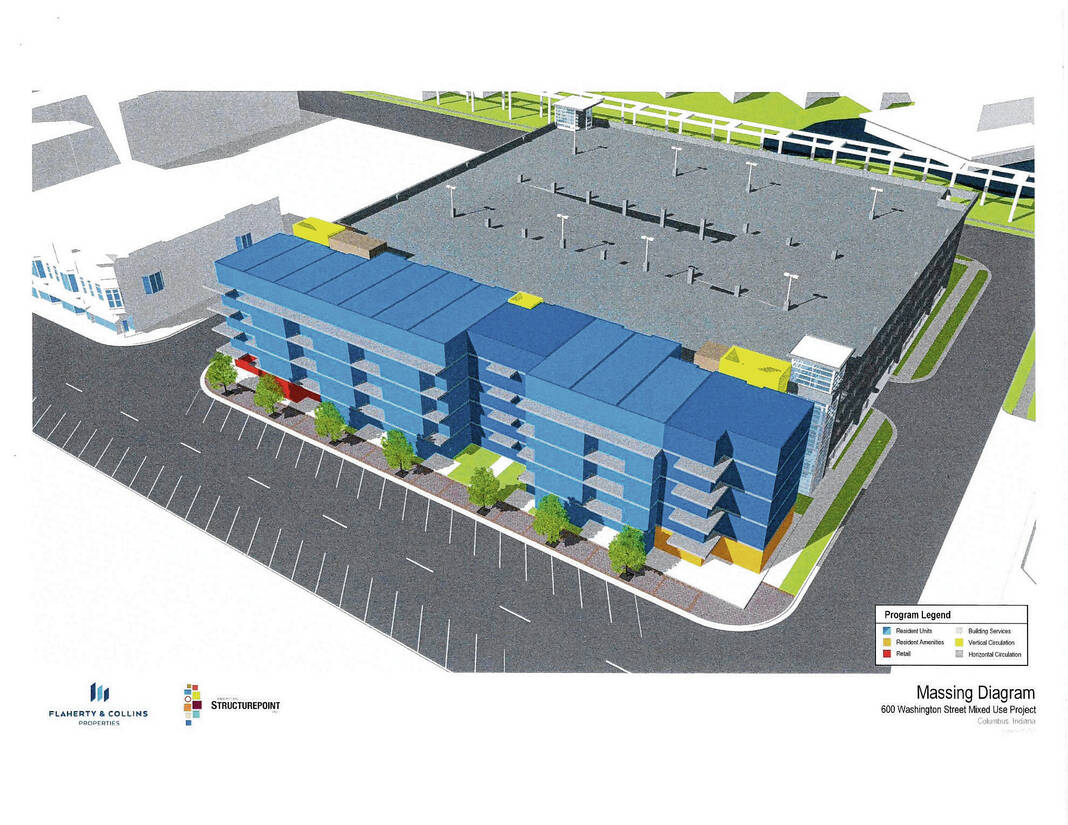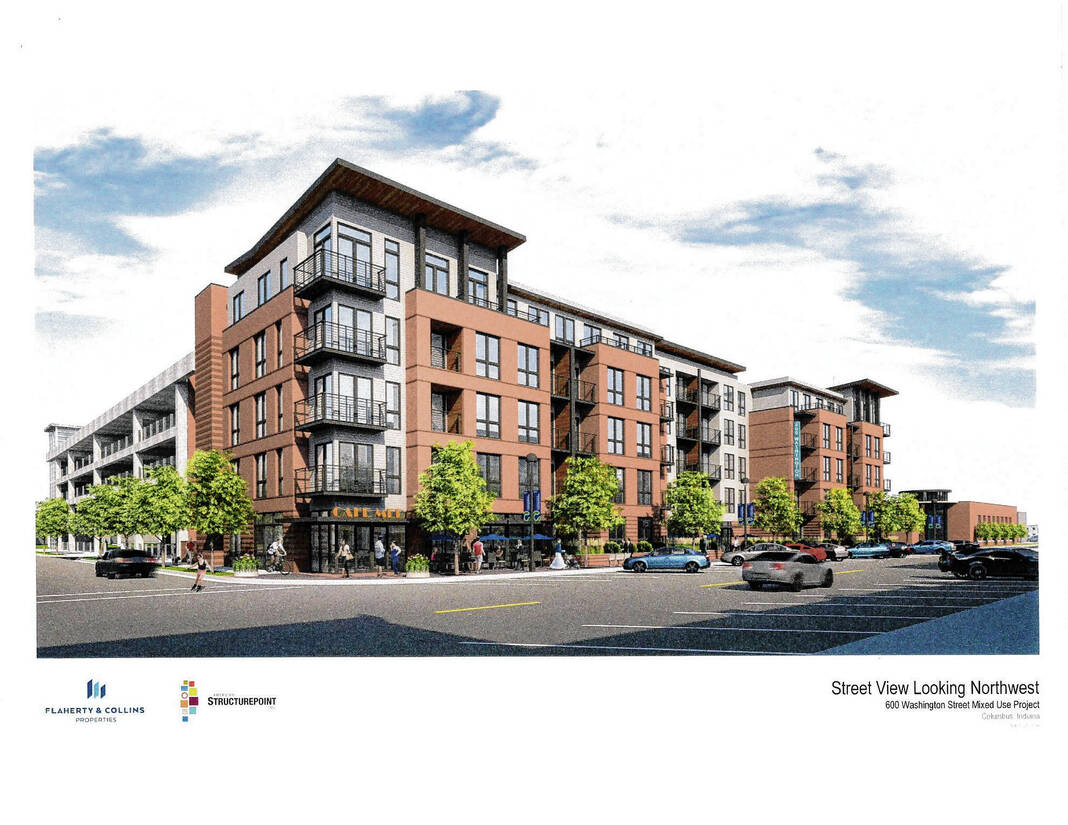
Photo provided An artist’s rendition of a proposed mixed use apartments development on land near Cummins’ parking garage in downtown Columbus.
The developer on The Taylor apartment complex and urban grocer is proposing another downtown mixed-use development that would call for an approximately $5 million subsidy from the Columbus Redevelopment Commission.
Flaherty & Collins Properties is proposing to build the approximately $15 million development — an apartment building with about 57 units and some first-floor commercial space — directly in front of the Cummins, Inc. parking garage at Seventh and Washington streets.
Deron Kintner, general counsel with Flaherty & Collins Properties, presented an overview of the potential project at a special commission meeting on Wednesday. The item was on the agenda as a discussion item and no decisions were made regarding the project.
Kintner said that it’s his understanding that the land in front of the garage, facing Washington Street, has been vacant for some time. According to the county’s GIS system, the parcel is 0.38 acres.
“There’s been a few different proposals or concepts that were pursued but ultimately didn’t come to fruition,” said Kintner. “We were approached — one of those concepts, the developer had been involved a few years ago on it and, I think, kind of saw it wasn’t going to be able to make it work, approached us at kind of the same time Cummins did, saying, ‘Hey, since you’re doing The Taylor here and since this hasn’t been able to work for anyone else, maybe it could work for you.’ And this was back, probably last fall.”
He said that they’ve tried to stick with the previous developer’s concept as much as possible, as he believes it had received approval from some Cummins higher-ups.
Kintner said the vision for the project is a five-story building, currently expected to include 57 apartment units. The first floor is projected to have about 2,200 square feet of commercial space, some walk-up residential units and a residential lobby with some amenities. The other floors would contain residential units.
The project would present some “operational efficiencies,” with leasing and operations being run out of The Taylor, which is under construction at 725 Second St., said Kintner. Flaherty & Collins is the developer on this project, and the company’s construction arm is the general contractor. The company hopes for that particular development — which includes 200 units and space for an urban grocer — to open soon and be fully complete by late this year or early 2024.
He also indicated that residents at the smaller complex near the Cummins parking garage would be able to take advantage of the amenities offered at The Taylor.
According to Kintner, the proposed project at Seventh and Washington is estimated to cost $15 million.
“Unfortunately, that’s going up like crazy all the time,” he said.
Flaherty & Collins plans to buy the land from Cummins and have residents and commercial users pay the company for use of its parking. Kintner said that this is not expected to be too expensive; it’s just intended to help Cummins cover the cost of operations.
Additionally, Cummins is expected to contribute to the project by building a firewall between the new building and the garage.
However, there is a funding gap of about $5 million for the development to be viable, which is where the redevelopment commission would come in. Kintner estimated that if funding is approved, they would hope to start construction in spring of 2024.
The commission previously contributed funding to the development of the Taylor, which is expected to cost $41 million, per estimates from Flaherty & Collins. The city agreed to invest $11.8 million into the development under the project agreement, according to Bruce Donaldson with the Indianapolis law firm Barnes & Thornburg.
City officials have said in the past that the development’s property tax dollars will reimburse the city for its contribution. The commission also committed to selling property for the development at minimal cost to the developer.
The Taylor is a luxury apartment complex that will be made up of studio, one-bedroom and two-bedroom units. The website for the complex lists different floor plans ranging from 550 to 1,550 square feet. The Taylor is also expected to include amenities such as a swimming spool, “bike fixit station,” community lounge and kitchen, “bark park and dog spa,” fitness center and grilling station.
When asked about pricing, Kestler said he would guess that the general range for rent would be $900 to $1,500 per month, with some units costing more than $1,500 per month due to size, upgraded finishes or location.
In discussing the concept at Seventh and Washington, City Councilwoman at-large Grace Kestler, who is a liaison to the commission, expressed concern that the proposed apartments are also likely to be expensive. She said that given the need for more affordable housing in Columbus, the development might not be the best use of the commission’s Tax Increment Financing dollars.
Commission member Kyle Hendricks agreed with Kestler’s concerns.
“I think that our work can be seen as unbalanced when you look at it from an equitable standpoint,” he said. “And I think that there’s a lot more that we can do in that area.”
Kintner said that increasing the housing supply should serve to drive down prices. He also estimated that approximately 20% of Flaherty & Collins Properties residents earn under the average median income, with this happening “organically” as people choose to live with roommates, select smaller units or spend more on housing.
“We do as much affordable housing as anyone,” he said. “We would love to come down here and give you 100 units, depending on the scoring and what the state, for the tax credits — we definitely want to put that on the table, bring on our team down who does that and give you some real numbers to address these problems, because it’s going to be hard to do it in a 50-unit development.”
In discussing price, he also said that Flaherty & Collins spends a great deal on developments like The Taylor and the Washington Street concept because they are considered to be an “an economic development tool” for cities.
“Most places bring us in for the economic development — not other governmental functions, which are equally important,” said Kintner. “But it’s to attract and retain employees and employers.”
He said that this will be important as remote work increases, since people will have more choice in where they live.
“As we try to activate the downtown and make it more vibrant, putting another 300 people or 400 people downtown, we don’t want to lose sight of not just the TIF dollars the property’s going to generate, but also the money that they’re going to spend downtown,” said commission president Al Roszczyk.
City Councilman-at-large Tom Dell — who, like Kestler, is a Democrat — expressed support for Flaherty & Collins’ proposal, saying that it will have a “substantial” economic impact for downtown Columbus.
He said that while he appreciated Kestler’s comments, he believes there are other developers that focus on moderate to low income housing and have identified areas in the community that would be more impactful. He added that one possibility is to expand TIF districts to support future and existing affordable housing projects.
“When you put a developer that does moderate to low income housing in numbers of 150 to 200, I think makes your dollar investment go farther,” said Dell. “And when you look at how many people we’ve got on the waiting list, I think that impact is substantially better than the five or 10 units that you might collect in the existing development. I would just like to say that I think you guys have to look at where you can make the most impact with the dollars you have to really help the overall vitality and economic impact in the city of Columbus.”







